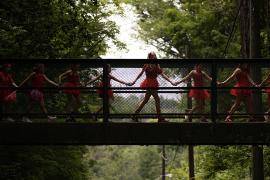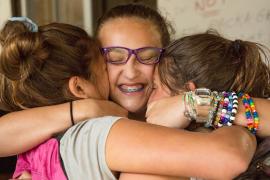Building Camps That Care About Kids—Fourth in a Series of Four Articles
“The fact that campers are happy and active does not necessarily mean that the camp is achieving important objectives. Children often have superficial objectives which make them happy. We all want our campers to be happy and reasonably active, but we cannot judge the effectiveness of the camping experience on that alone . . . it is not a complete criterion of success (Richard S. Doty, The Character Dimension of Camping, 1960).”
Camps pride themselves in happy campers, good return rates of campers and staff, and outstanding facilities. Doty, in reporting on research done in the 1950s, challenged readers to understand the three dimensions of camping:
Dimension I – What is at camp—equipment, site, people
Dimension II – Experiences people have at camp—activities, group living
Dimension III – What effect the other two dimensions have on the camper
Directors undoubtedly concur with Doty that campers may or may not have positive, developmentally-appropriate experiences simply because program and facilities are provided. What matters is what happens to the camper.
For this reason, in the new millennium, ACA pursued a systematic program of research and evaluation of the camp experience. The Program Improvement Project (PIP) is the latest of ACA’s ground-breaking efforts. Results of this project have been included in the three previous issues of Camping Magazine and have reported on significant findings about youth perceptions of the camp experience. More details of this study can be found in the booklet Innovations: Improving Youth Experiences in Summer Programs (ACA, 2006 and on the Web at www.ACAcamps.org/research).
The Community Action Framework for Youth Development (Gambone, Klem, and Connell, 2002) is the central framework that puts into perspective what is needed to help young people develop into adults who are economically self-sufficient, able to sustain healthy family relationships, and contribute to their community. If camps want these accepted outcomes, research shows that our youth must be provided with four critical supports and opportunities:
- Multiple supportive relationships with adults and peers
- Physical and emotional safety
- Challenging and engaging activities and learning experiences
- Meaningful opportunities for involvement and leadership
Earlier articles noted that of these four areas, camps, as well as other youth programs, have the greatest room for improvement in the area of youth involvement. In fact, in the baseline surveys administered to more than 7,600 campers in the summer of 2004, only 5 percent of campers reported optimal experiences in the youth involvement category, which includes the dimensions of decision making, youth leadership, and belonging. Sample questions from these dimensions include:
- Decision making: How often do you get to decide what activities you’re going to do here at camp?
- Leadership: How often have you helped plan activities and events?
- Belonging: How strongly do you agree or disagree that you feel like I belong here, or if you didn’t come to camp you would be missed?
In looking at Figure 1, camp leaders are challenged to understand their high return rate of campers while seeing results showing a low percentage of campers who have a real sense of belonging at camp. Youth programs must make a choice about whether to be merely satisfied with returning campers or to press beyond “happy to return” in favor of providing developmentally optimal experiences that promote belonging, decision-making, and leadership. The latter often requires program leaders to change from a model of efficiency in decision-making to a model of allowing youth to learn the challenges of leadership and decision-making. This is a skill that will benefit campers for life and will enhance their sense of belonging.

Learning About Youth Involvement
When faced with the reality of very low youth involvement indicators that left a huge gap requiring growth, the PIP camps rose to the challenge. All twenty-three camps in the PIP project made an effort to address the need for decision-making, leadership, and belonging. Eighty-three percent of the PIP camps saw their efforts result in significant improvement in youth involvement! Intentionality does make a difference!
Perhaps none of the other three developmental areas provided the impetus for as much soul-searching as youth involvement did. When directors in the PIP process (or in conference workshop sessions for that matter) saw these low benchmarks, expressions of disbelief, doubt, and a healthy dose of “Lake Woebegone-ism” appeared on their faces. Surely, their campers were above this very low average! Certainly, the survey questions must not have been very good. Undoubtedly, their campers would see this situation quite differently. Of course, this was wishful thinking as they soon found out.
The reality was sobering. When the PIP directors discussed the survey results with their campers, the campers were not surprised at the results. Karen Lubecki of Camp Glengarra (a girls’ camp with a girl-planning focus and mission) described it this way: “The campers felt they really didn’t have a voice in anything. Everything was done for them. The staff started out giving them leadership and decision-making authority, but soon took it away from them when the process took too long, or the staff didn’t like the decisions that were about to be made. All the campers seemed quite verbal about this fact. I didn’t find any camper who expressed it differently. Campers wanted more responsibility, but it was denied them.”
At Camp Miniwanca, Craig VanKempen learned that campers wanted a lot more choices about how to spend their time. The Miniwanca staff also learned that new campers had trouble “breaking in” to camp and feeling like they belonged, because no one bothered to really teach them the camp songs and traditions.
In both camps, campers wanted more say about their cabin/tent mates. Older campers and returning campers wanted opportunities to help new or younger campers. Campers who “know the ropes” could help new campers learn the songs, the traditions, and the way to be true “Miniwanca/Glengarra/Your Camp” campers. Staff often “treated them like babies” in the words of campers. Staff gave them a task or let them choose a responsibility but took it away from them as soon as it seemed to not go the way the staff wanted it to go.
Directors could see the reality that many camp program decisions were made by staff because of perceived efficiency. Directors also recognized that the efficiency gained by staff decisions couldn’t have nearly the same impact on camper outcomes as camper experience in leadership.
The Staff Respond to Youth Involvement
The trickiest part of improving camp programs is empowering the staff to buy into the concept and then getting out of the way of growing camper leadership. The challenge is that many camps have grown their own staff. Some campers returned summer after summer to camp, participated in CIT programs, junior staff programs, and finally rose to the level of “power” as a senior counselor. But wait—the directors changed the rules and indicated that campers (not staff) needed to learn to make decisions and gain the experience of recovering from mistakes.
The transition from a “controlling staff” to an “empowering staff” was not an easy shift for staff. Karen Lubecki and her assistant Jennifer Horskins needed to work together to help staff understand that the camp schedule was not the key. If the cookout took longer because campers needed to learn to lead and coordinate, that was more important than staff stepping in to the rescue in order to keep things on schedule. Staff needed to see and understand the experiences and learning opportunities they were taking away from the campers when they stepped in and took over. One solution was to have the administrative team out in camp to coach and support the staff as they allowed camper decision-making and leadership to happen.
Miniwanca staff needed to change their traditional schedule to allow for more camper choice. They wanted to be sure each camper had the opportunity to participate in activities they were interested in—rather than participating in activities of less interest that made for a more efficient, easy-to-manage schedule. Program improvement took work, but it paid off.
Both camps now seek camper input for program planning on a year-round basis. Chat rooms and geographically central meetings and groupings provide the means for input to facilitate camp change. Staff training is changing as well. The staff is developing the skills of facilitation and “de-briefing” activities and experiences. Glengarra reports that the camp’s enrollment went up by 12 percent in resident camp and 11 percent in day camp in 2006. Will every camp achieve that? Perhaps not, but this camp’s experience does support the value of the change process. Glengarra was willing to look at the camp structure, policies, and activities to see where change could support the expressed needs of the campers. Their comprehensive approach, unity among administration and camp staff, and commitment to involve meaningful camper participation in decision-making worked to bring about positive change.
Steps for Improvement in All Camps
Material in ACA’s publication Innovations clearly describes the path to improvement. Examples are provided to enhance this outline:
- Gather information on youth’s experience of camp. This step is more than a satisfaction survey. It is systematic gathering of the perspectives of all campers on the mission and outcomes of your camp as well as the developmentally-appropriate supports and opportunities for positive camper growth.
- Gather input from staff. See how their feedback resonates with the information from camper groups.
- Assess your organization’s practices. Look at your camp structure, policies, and activities. Find congruence in these areas.
- Brainstorm strategies to accomplish camper/staff suggested improvements. Look for actions that will make a difference and demonstrate to campers and staff that you are listening and responding to their input.
- Choose what to implement in the next camp cycle. You will get more suggestions than you can realistically implement in one summer. Prioritize. Involve camper groups in helping to decide next steps.
- Tell campers what you will do. Enter into a partnership with campers to keep them informed of changes you plan to make. Involve them as well as your staff in implementation. Communicate, communicate, communicate. When they see you have listened, they will believe!
- Take stock. Everything must be intentional. Continue to collect input from camper and staff groups. Continue to refine practices. Continue to evaluate the implementation of your mission.
More than one camp learned in the PIP process that their mission statements represented words that sounded good to the public but had little effect on the day-to-day operation of camp. Changing that made staff training easier and better. A clearly articulated mission helped campers and parents resonate with what camp was all about. Goals based on the mission established a criterion for success that embodied the third dimension of camp: outcomes in campers.
But some will say, “I’ve counted my beds and they are full. Isn’t that enough?” It may be good, but it is not enough. The theme of this series is “Building Camps That Care About Kids.” Will your camp be a “builder” or a counter?
HE BRIDGE BUILDER
An old man, going a lone highway, Came at the evening cold and gray,
To a chasm, vast and deep and wide, Through which was flowing a sullen tide.
The old man crossed in the twilight dim- That sullen stream had no fears for
him; But he turned, when he reached the other side,
And built a bridge to span the tide.
“Old man,” said a fellow pilgrim near, “You are wasting strength in building here.
Your journey will end with the passing day;
You never again must come this way.
You have crossed the chasm, deep and wide,
Why build you this bridge to the other side?”
The builder lifted his old gray head. “Good friend, in the path I have come,”
he said, “There followeth after me today
A youth whose feet must pass this way. This chasm that has been naught to me
To that fair-haired youth may a pitfall be. He, too, must cross in the twilight
dim; Good friend, I am building the bridge for him.”
—Will Allen Dromgoole (1860-1934)
Youth Involvement—What Worked?
For the camps with significant improvements in Youth Involvement, the following strategies are examples of changes implemented in their programs:
- Revamping staff training to provide them with strategies to facilitate camper-planned activities rather than staff-directed activities.
- Involving campers and staff in decision-making through camp-wise or unit camper councils as well as providing more opportunity to plan and conduct cabin/group activities.
- Providing older campers with more management opportunities in the day-to-day running of camp.
- Allowing campers to choose more of their daily activities.
- Providing opportunities during each camp session for campers to interact with directors to share observations, wishes for camp, and program ideas.
- Utilizing camper ideas in programming.
Marge Scanlin, Ed. D., former executive officer of research, American Camp Association.
Craig VanKempen, boys camp director, American Youth Foundation’s Camp Miniwanca.
Karen Lubecki, director, Girl Scout Camp Glengarra.
Originally published in the 2007 March/April issue of Camping Magazine.



